All-Asia pass
Cathy Pacific has a great deal: a flat fare for flights from New York to their hub in Hong Kong and (almost) unlimited travel on their route system. I along with my buddy Chuck sign up for an ambitious three week itinerary.
Bali
Even after the twenty hour flight to Hong Kong (stopover in Vancouver), it’s still another five hours to get there. Bali is not only on the other side of the world, it’s also on the other side of the equator. With the crossing of the date line, it takes two days the journey takes two days.
In a word, Bali is overrated. The description of “paradise” must have come from people who live on the North Sea or in the industrial Midlands. For those who have already seen palm trees, greenery and beaches, it’s nothing exceptional though the terraced rice fields are quite pretty.
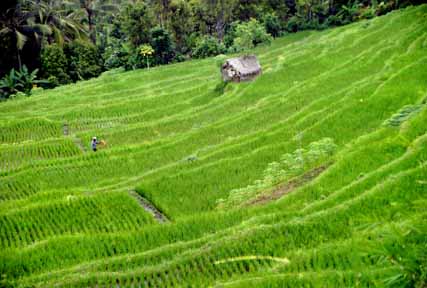
Initially we stay inland Ubud, the “artists center.” That means row after row of “galleries” offering mass-produced paintings at astronomical prices, but not much else. Our hotel (self- dubbed a “resort”) has a nice view overlooking a valley but is falling apart. Chuck bets me that it was built more than thirty years ago; I said less than 10. You can guess who won the bet.
After two nights, we move down to the beach at Sanur and find a hotel where German tour groups stay. (That is a sure way to pick a place in good repair -- if anything is out of order, they have the one responsible shot.) The beach itself is narrow, rocky, encrusted with seaweed, waveless, and infested by hawkers.
Most tourists come to Bali for 2 or 3 weeks. I can’t imagine what they do here. Their daily excursion itineraries are posted in the hotel lobby: a typical day consists of loading the bus, driving to a temple, staying for hours, group lunch in an overpriced tourist trap, a handicrafts display (i.e., forced shopping), then return. We hire a car and driver and see everything worth seeing (all four sites) in a day and still have time to spare.
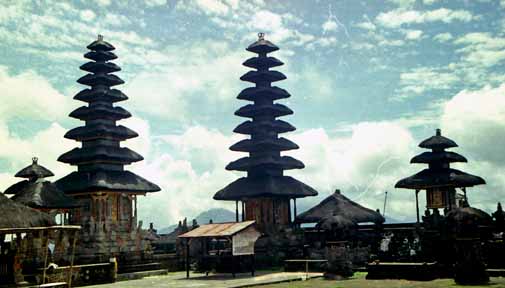
The entire economy of Bali revolves around hustling tourists. At Mas, the “woodcarvers center,” we stopped in a typical roadside place. Chuck asks the price of an unexceptional piece about 16” tall. “Four thousand U.S. dollars.” I look at a small, nicely painted bird figure: $600 US. That was the end of that visit.
The central market in the big city, Densapar, has plenty of cool souvenirs at reasonable prices, generally about a tenth of what they are asking at the source. We load up there.
Bali is supposed to be dirt cheap, but in reality only if you want to live like a native. Except for restaurants, the prices on anything you would want have been dollarized. The collapse of the currency has translated primarily into a windfall for the hotels and other providers. It’s cheap by western standards, but not by third world standards. Contrary to widespread belief, the people are not particularly friendly or attractive.
We left New York Sat night and arrived Bali Monday afternoon. Our departure comes on Thurs. afternoon. Our only complaint is that plane didn't leave early enough.
Bottom line. Worthwhile if you are in the neighborhood, but hardly worth a separate trip
Taiwan
It's a long hike back across the equator and through Hong Kong; we don’t get to Taipei until midnight. In the morning we visit the National Palace Museum, the repository for the imperial art treasures. They were crated up and moved repeatedly to save them successfully from the civil war, the Japanese, and the communists until coming to rest in Taiwan in 1949. As we are repeatedly reminded, the foresight of Generalissimo Chang Kai Shek in removing them from the mainland saved them from destruction by the Red Guards during in the Cultural Revolution in 1967.
There are too many paintings and bronze pots which look alike, but the stuff is amazing. Entire boats with men and sails carved from an olive pit. Ivory carvings so detailed one needs a microscope to see. The collection is so vast that only 10% can be displayed at any one time.
That afternoon we journey out of the city to Wulai, a gorge and waterfall. It’sood chance to see the countryside. Taiwan was a backwater, provincial island until Chang set up shop here. It is mountainous and rural except what has been built since the war. Wulai has an "aboriginal village" so visitors can gawk at the original inhabitants of the island, who look and dress like (American) Indians.
Saturday morning we visit the Chang Kai Shek Memorial, which, after the Palace Museum, is the other thing to see in Taipei. A giant statue, lots of reverence, but no Chang souvenirs. In fact, no Chang jokes allowed. Or smirking. If a Brobdignagian bronze Chang not enough, can view a lifesize mannequin in a recreation of office. And all his uniforms. And pictures from his life. And his cars. And his personal effects.
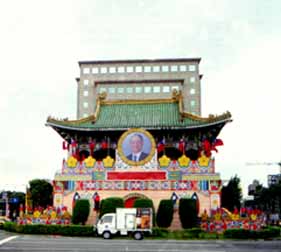

The rest of the morning we wander about the city and stop by a 400 year old temple that is probably the only thing in Taipei pre CKS. The city is modern, crowded, and has lots of American franchised restaurants and stores, but not particularly clean or attractive.
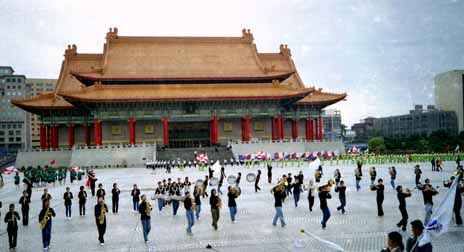
After lunch, it's off to Chang Kai Shek airport for our flight to Japan.
Unless one wants to travel around rural Formosa, a day and a half for a visit to Taiwan is just about right.
Japan (or, Down and Out in Kyoto)
We arrive at Osaka about 8 PM, where we undergo the most thorough scrutiny at immigration: you must show your return ticket; your passport examined for every place you have ever been; if you have been any of a long list of countries in the past two weeks, there is a quarantine screening. I guess we aren’t deemed (too) undesirable, 'cause they let us in.
This being Japan, our bags are already at the carousel. Kansai Airport is new and built on an artificial island in the middle of Osaka bay. We didn't have a hotel reservation, so we stop at the accommodations kiosk. Kyoto? "All full." Osaka? "All full." Airport area? "All full too." With this cheery news, we figure we might as well stick with the plan and go to Kyoto.
The sleek, shiny and spotless train pulls right into the airport termina.. The conductor comes up and bows when requesting my ticket. After he is done with the car, he stops at the door, turns around, and bows to the car. The ride is swift, smooth, and silent. After forty-five minutes we arrive in Kyoto.
The station is large and bustling. Unfortunately, the visitors bureau is closed. We set out to find a hotel. EVERY place is full. It is a a three day weekend, and all the Japanese have head to Kyoto. (And there are not that many hotels to start with). About 11 PM we find a place that has one room that they are holding for a 10 PM arrival. If it is a no show by midnight, they will let us have it. So we hang around for an hour. Five minutes before the deadline they arrive. So we figure we will just head on to the next city.
Well, it turns out that not only do they roll the sidewalks in Kyoto up at night, the TRAIN STATION CLOSES TOO! At that point it looks like we were going to have to spend the night on the street. Then three 20-somethings popped out, having alighted from the last train in. They had been out drinking in Osaka. We ask for some guidance, and they said "Much too much trouble to find a place. Why not come home and stay with us?"

We pile in a couple of cabs and went to their microscopic apartment. And I mean small! If you bought a CD, you would have to throw one away to make room. The kitchen is about the size of a refrigerator, as is the bathroom. There aren't any proper beds -- everyone sleeps on mats rolled out on the floor. And so do we. We all stay up to 3 AM drinking (which helps to make the floor seem somewhat softer) and having a fine old time. The next morning Chuck and I go to the visitor's bureau where they find us room at a businessman's hotel out in the suburbs. The rooms there, too, are a remarkable feat of miniaturization.
Kyoto is full of old Jap-type stuff, being the only city which we didn't bomb in the war. After a couple of temples and castles, we decide that we get the general idea and that one day is enough.

The next day we move on to Osaka, the second largest city in Japan. It is v ery modern due to large scale urban redevelopment made possible courtesy of the US Air Force. We spend the day and a night in Osaka, and the next day head back to Kansai. We wanted to take the bullet train to Hiroshima, but would have been unable to get back in time (it was fully booked by travelers returning at the end of the long weekend.)

Japan is impressive in many respects, but the chief impressions are that it is CLEAN and POLITE. You can eat off the subway floors. Taxicabs are dustless, with crisply-uniformed drivers wearing white gloves, and the doors open hydraulically. No litter anywhere. No slapdash, rude, or indifferent service: buy a donut at Dunkin Donuts and the clerk meticulously wraps it and presents it with a bow. Vending machines sell everything and anything, including beer and bottles of whiskey, and none are out of order. Everything is perfect. Everybody is friendly and helpful.
Chuck and I agree: Japan is a place to return to.
Sri Lanka
or Ceylon, as the Tourist Board still calls it. I guess it's one thing to insist on principles at the UN, and another when it comes to trying to attract visitors to some place with a stupid name no one has ever heard of and can't pronounce.
Ceylon is far away (look at the map); we don't get there til midnight. (Just like India, all the international flights arrive and depart in the middle of the night.) We check in to the Intercontinental in Colombo, the capital. Don't see any other guests that night or at breakfast.
Due to the civil war between the government (Sinhalese ethnic group, Buddhist) and the Tamils (from India, Hindus), the city looked like it's been occupied by an invading army. A one hour walking tour in the morning convinces us that it's time to move on. We take the train to Kandy, the second largest city. It's in the highlands in tea country, and was the Sinhalese capital. It’s a very scenic ride that takes 3 and 1/2 hrs to go 70 miles but costs a dollar for first class. The rolling stock was inherited from the British. While we are there they have big celebration over reopening a trestle that washed out in 1947.
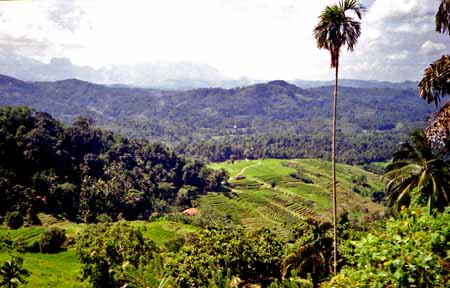
Kandy, laid out around an artificial lake, is kind of nice. Its principal attraction is the temple holding Buddha's tooth (so they say). Security is high – the temple got blown up by a truck bomb in January and just reopened. We stay at the Queens Hotel, an 1844 Victorian masterpiece right across the street from the Tooth Fairy Temple. It got blown up too and has been nicely renovated.
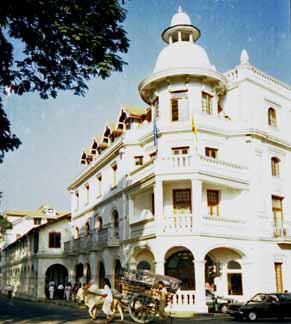
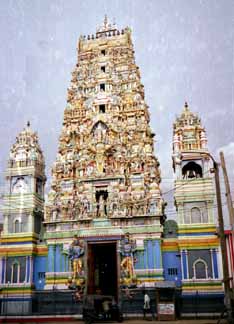
We hire a car and driver which allows us to cover all the sights in a day. The temples are kind of ragged but the Pinnewala Elephant Orphanage is pretty cool. We visit a tea plantation; the processing plant was built in 1902 and it looks it – the machinery is all original. The plantation was nationalized in 1948: no surprise that all the workers are just sitting around. Hygiene is nonexistent.
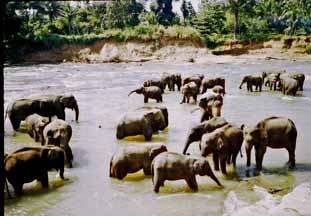

Speaking of which, the whole country is like that: a third-world socialist wonderland. Everyone sits around bitching about colonial exploitation; meanwhile the only things that work or look decent were built by the British. The movie theater in Kandy is The Wembley -- it doesn’t look like it has seen a coat of paint in fifty years; I think they are waiting for the former owners to come back and do it. As they say in Zambia, "we are waiting for your donation." Because a lack of investment has served to limit the amount of ugly third-world concrete vertical rubble heaps that normally replace colonial buildings, Ceylon is a bit like a shabby museum piece. The botanical garden is very nice.

After Kandy we take the train back to Colombo. Plane out isn't until 2:00 AM so we want to go down the coast to Galle. Problem: we wouldn't get there til almost dark, so we waste the rest of day in Colombo.
Ceylon has a reputation as a tourist unfriendly place. It's not that people are so bad -- most are nice -- but that 20% of the population is engaged in trying to hustle the few tourists that do come. There are not alot tourists, but neither is there a lot of tourist infrastructure. It is CHEAP place to visit, and offers cool souvenirs. Mostly saw Brits there on long vacations
The island has considerable natural beauty, but a combination of extreme distance, civil war, and unfriendly reputation means I don't think any of you are going there anytime soon.
Philippines
Manila is a true hellhole. It's third world chaos cum urban collapse. The streets are gridlocked, and the air is so bad that by the end of the day you think you've been tear-gassed. Every store, including 7-11s and MacDonalds, has armed guards, and half the vehicles on the streets are armored. It's a good thing that there is nothing to see because you couldn't get there to see it anyway. We got into a cab to take a look at the old walled city downtown (Intramuros); an hour and a half and 3 miles later we told the driver to turn around.
The Filipinos are horrible -- small, brown, unattractive, and belligerent. As the only country in the Pacific Rim to have missed out on the Asian economic boom (not for lack of foreign aid), they have a (well-deserved) national inferiority complex. It's all our fault (they think), and they hate us for it. (The ones over there do; the smart ones are over here.) They are immensely prideful (of what, I don't know). Corruption of every sort is rampant.
That said, we have a good time. Chuck's college buddy lives in Manila, where he works for the Asian Development, one of that international taxpayer sinkholes. We get to experience the decadent life of an expatriate world beauracrat. They live in a bubble, but it's a fun bubble.
The first full day we decide to go to Corregidor, the island bastion at the mouth of Manila Bay. By the time we got to the dock, the once-a-day tourist boat has already left. Undaunted, we hop a passenger ferry to Bataan, all the while recalling the numerous news reports over the years of Philippine ferry disasters. Once there we took The Bataan Death Ride on a motortricycle down the coast. On the shore opposite Corregidor we engage Charon The Boatman to take us over to the island. On the island, we get a private tour before catching the tourist boat back.
Corregidor has been preserved as a shrine since the end of the war. In 1942 McArthur abandoned his men and fled (oops, followed orders under protest to evacuate). We surrendered the place in pretty good shape, but bombed it to bits taking it back in 1945. The island bristles with batteries of giant guns. The barracks and other buildings are in ruins, but photograph nicely. The command tunnel is a museum. It's all quite impressive.

The next day we head out to Angeles, site of the former Clark Air Base. The people there fondly remember the Americans and their payroll; you can imagine how well it's done since 40,000 well-paying jobs disappeared. It is supposed to become the new airport for Manila, but they are probably “awaiting our donation.” Most tell-tale is the former officers' housing, regular US suburban-type construction, now mile after mile of empty shells. As soon as the Air Force left the Filipinos came and stripped everything: doors, windows, trim, plumbing, and wiring to incorporate into their shacks
Angeles lies at the base of Mt. Pinatubo. We spend a day hiking through the lunar landscape left by the volcanic ash, following a river which still runs hot from geothermal activity. A week later I was am shaking ash from my sneakers.
Manila/Angeles are also noted for their profusion of girlie bars, but I will not bore you with the details.
Bangkok (or, my own Star(r) report)
Airport ***
Public transportation ***
Touristic attractions ****
Hotels ****
Air quality *
Prices/value ****
Friendliness ****
Souvenirs/shopping ****
Traffic *
Pulchritude of populace ****
Weather **
Food ****
Adult entertainment ************************************************
Thailand has got this tourism stuff figured out: the city and facilities very modern; lots of tourist police, info booths, and helpful signage; and an elevated mass transit system and subway are under construction. Although extremely congested, traffic is orderly and does crawl along (in contrast to Manila, where it doesn’t move at all). There is cool stuff to see and buy, and a bargain to boot. People are friendly and attractive, proud for good reason. They justneed to do something about the weather – the heat and humidity are oppressive.
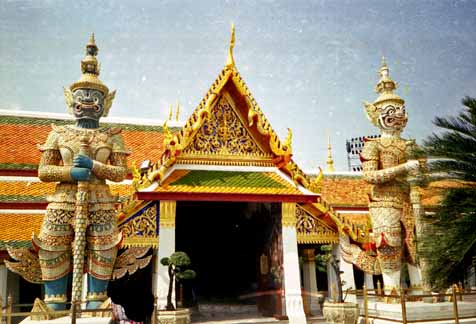
We are there but four days, so don’t have time to get out of city. Next time I will stay longer and head north to Chang Mai and south to Pattaya.
Bottom line: Thailand is clear winner in the southeast Asia tourist competition.
Hong Kong
Having transited through the airport five times already, we finally head for an exit. The new monster airport at Chek Lap Kok on Lantau Island is up and running. The terminal is about a mile long. Immigration and customs are polite, efficient and speedy. The swift, silent Airport Express train runs from right inside the terminal to newly constructed stations in Kowloon and Central.
Despite the handover, Hong Kong remains one of the great cities of the world. Everything remains clean, ultra-modern, and efficient. We only have two days, which I spend shopping and revisiting favorite sights.
And then, home.
A final word about Cathay Pacific. For $900 I rode them 38,000 miles with no complaints. Food and service top notch. (In contrast, it only takes a 1 hour flight for me to hate Delta all over again.) They are repeating their all-Asia pass offer for 1999. Everyone of you should take advantage of it.
Coming attractions: Belgium (March 1999); Bulgaria (June 1999).
Trip date: September - October 1998